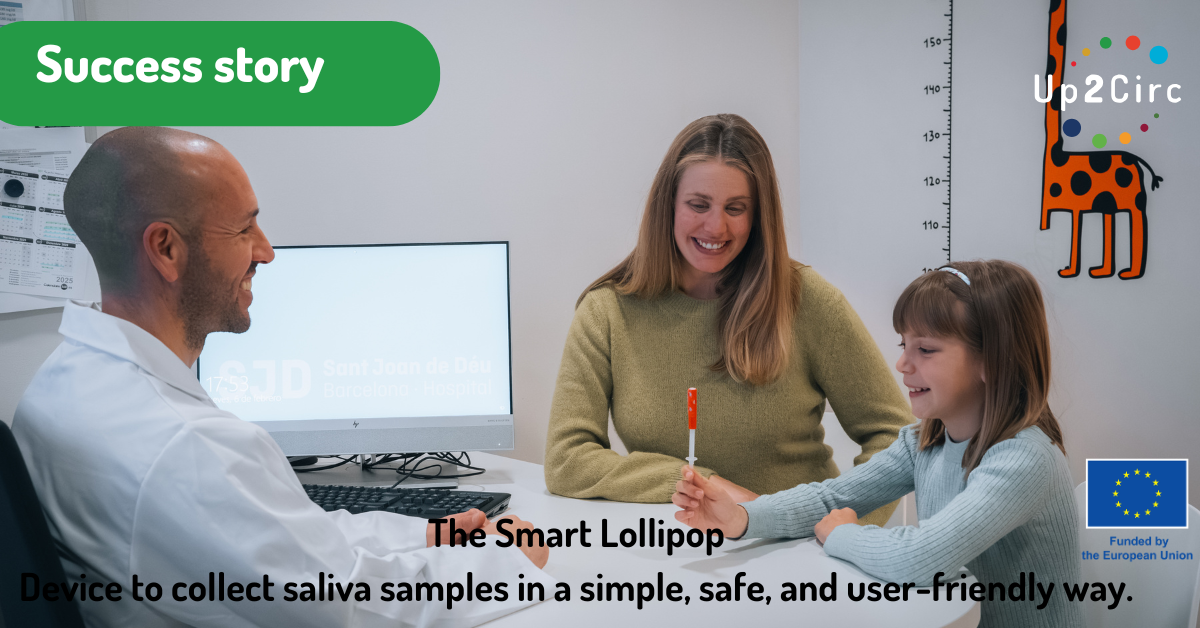
Feasibility study to evaluate the devise The Smart Lollipop to reuse safety and efficiently, instead of being discarded after a single use
COMPANY NAME
Happy Innova SL
COUNTRY
Spain
SECTOR
Healthcare
CIRCULAR BUSINESS MODEL
Circular supply chain
Recovery and recycling
CHALLENGE
During the product development phase, we identified that one of the components had the potential to be reused. However, implementing such a model required a deeper understanding of the barriers we might face, both from a technical and regulatory standpoint. We also wanted to evaluate the financial impact of reuse and detect early actions that could generate a positive effect without waiting until the final stages of development, when making changes becomes much more difficult. The feasibility study was to evaluate whether one of the components of The Smart Lollipop could be reused safely and efficiently, instead of being discarded after a single use.
SOLUTION
We are a healthtech company that develops innovative non-invasive medical devices for the diagnosis and monitoring of diseases. Our first product is The Smart Lollipop One, a lollipop-shaped device designed to collect saliva samples in a simple, safe, and user-friendly way, especially for children and vulnerable patients, which performs the diagnosis with laboratory support. Through the Up2Circ project, we launched a feasibility study to explore whether reconditioning this component could be a viable alternative to the traditional single-use model. This initiative is fully aligned with our mission: to create innovative solutions that improve healthcare experiences while also reducing environmental impact and encouraging more responsible use of resources.
CIRCULAR ECONOMY STRATEGIES/BUSINESS MODEL IMPLEMENTED
As we progressed in the research and development of our product, and especially after gaining a deeper understanding of how the medical device industry typically operates, we became increasingly aware of the enormous amount of waste the sector generates. Conventional models tend to rely heavily on single-use, disposable products, and very few components are reused or recycled. We realized that The Smart Lollipop One also fell into this single-use category, and that sparked an internal reflection: could we redesign part of the product to allow for reuse or recycling, without compromising safety or functionality, and while still keeping it financially viable? That question became a key driver of our circularity efforts.
IMPACT
From an environmental perspective, we measured:
- A 92% reduction in waste generation, which means hundreds of kilos of waste avoided for every few thousand units.
- A 28.6% reduction in CO₂ emissions per unit, even accounting for cleaning and transport.
These numbers clearly show that circularity can deliver real, measurable benefits, even in a highly regulated and complex sector like medical devices.
However, it’s important to be honest: transitioning to a circular model is not simple. It requires in-depth studies on regulatory compliance, product safety, and the logistics of reuse, as well as the identification of qualified partners capable of managing reconditioning under medical-grade standards before a circular model can be deployed.
KEY TAKEAWAY
One of the key takeaways was that a circular approach is only viable at certain scales and we’re not there yet. That said, we now have a better idea of when it might make sense to implement it and what conditions need to be in place. We’ve already identified potential partners and regulatory aspects to work on, which helps us reduce uncertainty and be better prepared for the transition when the product reaches the right stage.
Also, we developed a calculator tool that allows us to simulate the environmental and financial impact of adopting a circular model under different production and logistics scenarios. This tool will be especially valuable in the future, once we have more concrete data on costs and operations at larger scales. The project helped us understand the real challenges and opportunities of circularity in the medical field. Thanks to the project, we now have a validated model, clear next steps, and better tools to make sustainable decisions as we scale.
